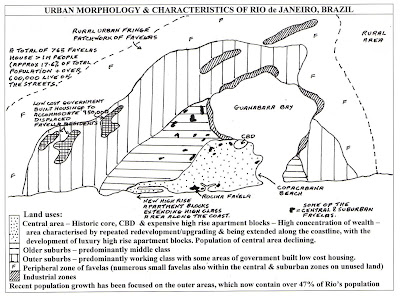
Land use map of Rio

Model of Brazilian cities
The problems of Rio de Janeiro include:
Shanty towns often located on unsuitable & often hazardous sites.
Residents lack tenure of the land they live on – most squatter settlements are built illegally.
High concentrations of the poorest people in society.
High levels of unemployment & very low incomes.
Unsanitary living conditions – no access to clean water supplies of sewage disposal.
Very poor access to medical services & high rates of disease (eg cholera) & high mortality rates.
High endemic levels of crime and violence as a result of poverty & lack of economic opportunities.
Poor locked into a downward spiral of poverty & poor health.
Many different schemes have bee tried to solve the shanty town problem, with varying degrees of success:
Post on schemes to improve conditions in the Favelas will follow soon!
2 comments:
Hi Mrs j, I am not from your school so i hope you do not mind me using your information. Your site was very useful in completeing my homework. Thank you.
Hi
Firstly I'd like to comment that Rio, like many cities in both LEDCs AND MECDs follows formulaic patterns. Just as all populations progress through the demographic transition model, so all cities develop and follow models, eg they may begin as small towns, expand and form a very dense and highly intricate and dynamic CBD, then expand via the construction of roads/transport routes, which in turn attract businesses, often initially industrial, but then follow by suburbs, which then become busy/dynamic and so transport routes are built out again and so on and so forth. Often a city is made of an agglomeration of such nearby areas, or sometimes even 2 cities join. Throughout this process, as well as economic and political processes, slums and squatter settlements are inevitable. They often show many issues faced by the country, such as polarisation of finances among the society, or rapid exponential growth/migration to a city, gentrification, and due to the lack of finances/resources these dwellers have, it is again, inevetable that they are located in hazardous sites as these are often the only areas of unused land left - this creates infill within the city.
Additionally it is very untrue that slum/squatter settlers are unemployed, many are employed in the informal sector (not regulated by governments or counted in the GDP), but provide the backbone of the economy, the case in Rio is that with millions of favelados, their employment is cheap and thus desirable, they often work in the secondary secture (manufactoring/production) such as construction or domestic services, but it is this secondary sector that the tertiary sector depends on, and in Rio 70% of the economic activity comes from the tertiary sector. Thus the favelados are a pool of labor, do not underestimate them. In fact in 1950, 50% of all the people in favelas were employed, and consider that favelas house a large percentage of those under 15 who are thus economically inactive.
Post a Comment